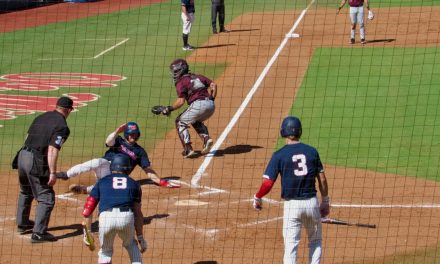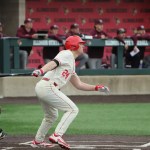
Three Under-The-Radar Rebels to Watch as the Ole Miss Hoops Season Begins

OXFORD, Miss. — The Ole Miss men’s basketball season is about to start. The Rebels have an exhibition game tonight against Trevecca, followed by the season tip-off next Tuesday when they play host to New Orleans. If you’re looking for more details on that New Orleans game and the rest of the non-conference schedule we’ve got you covered.
With such a high turnover of players from last year’s team, fans are likely wondering how this roster will allocate its minutes, especially since head coach Kermit Davis has already stated this team is his deepest group since coming to Ole Miss. In this article, we take a look at three under-the-radar Rebels to watch.
Helpful terms to know
Before we go further, there are a couple of definitions that can help you understand the scope of this article.
The first is what is an “under-the-radar” (UTR) candidate? In my eyes, an UTR candidate in basketball is one whose potential is overlooked or unknown. These are guys who could come in and provide a positive impact elevating this team’s ceiling.
The second term to know is a “swing skill.” A swing skill is a term largely used in the NBA scouting world to help establish the projection of potential prospects. For this one, I wanted to phone a friend of mine. I asked Ramin Baiat who covers the NBA Draft at The Close Up Magic to give us a special definition of what a swing skill is.
“A swing skill is a skill that most heavily influences a player’s ceiling. They are often associated with players taking the next necessary leap, whether a guy is a rotation player vs starter or a starter vs star. They’re the single most important skill needed to open up their games and maximize value.“
That being said, let’s dive into who’s flying under the radar.
Tye Fagan
2020 Stats: 9.2 PPG, 4.3 RPG, 1.1 APG. 58.7% FG Percentage, 27% 3PT Percentage
Swing skill: Half-Court Decision Making
As a player, Fagan brings starting SEC experience. His athleticism and burst are the big things that jump out when you turn on the film. On the offensive end, he can attack to the basket with a quick first step and is one of the better guard finishers in the SEC. His 58% FG percentage is similar to what a big man would shoot and a good one at that. His ability to finish on his own and in transition will make himself useful immediately.
Defensively, Fagan could be a good threat to have on the court. At times last year, we saw him match-up against some premier scorers in the conference (one that comes to mind is Cam Thomas). The most impressive part of his game is his rebounding ability for a 6’3″ guard. Per 40 minutes he would’ve averaged 7.8 rebounds last year.
There are some areas Fagan can improve. It’s no secret that perimeter shooting is the biggest one. Over his college career, he has only attempted 67 of them. He is a guy that could essentially shrink down the floor. The turnovers have also been an issue. Last year his 1.5 turnovers per game overshadowed his 1.1 assists per game.
Why He’s Under the Radar
Fagan’s skillset provides this offense with something no other guard on the roster can. His slashing and cutting ability off-ball could help perfectly in this new spaced-out Rebel offense. Having more playmakers out on the perimeter (i.e. Jarkel Joiner, Daeshun Ruffin, Matthew Murrell, Jaemyn Brakefield) it really opens up the ability for him to work on getting open cuts.
As stated earlier, is his ability to finish around the rim. Unfortunately, Ruffin and Joiner are likely going to struggle to get deep into the paint. This makes the need for a player like Fagan to have success even more important. The gravity that Ruffin and Joiner will provide could get Fagan opportunities to use that solid burst to attack closeouts.
Defensively, Fagan offers perimeter versatility with the ability to guard positions 1-3. There’s not a guard on this roster who I would say is a bad defender. Fagan really shines at the point of attack. If one of Luis (Rodriguez), Joiner, or Murrell gets in foul trouble, there is a player who can come in and not lose a beat defensively. Lastly with his rebounding numbers and how many come on the defensive end, he can start his own break.
Ole Miss wants to play faster this season and get out and run more. With Fagan’s speed, he can run lanes or pull it down and bring it up himself.
The swing skill is his half-court decision-making. For Fagan to have the best impact, he needs to be efficient. He has the scoring/finishing aspect down, as well as rebounding and defense. Fouls can always be improved on. However, is he going to pass efficiently? When you watch him play, he makes some “wow” passes with either hand, especially on attacks. The turnovers need to be cut out. If he can make every play with intensity and engagement he can be one of the most efficient players on this team and near the top of the SEC.
Here is a nice rebound by Anthony Edwards and he follows it up with a solid pass ahead in transition to Tye Fagan for an easy layup pic.twitter.com/8qGjj3pURX
— Zach Milner (@ZachMilner13) January 17, 2020
Austin Crowley
2020 Stats: 2.4 PPG, 1.5 RPG, 11.6 MPG
Swing skill: Shooting Consistency
A player many fans had high expectations for, Crowley has yet to find consistent minutes on the floor during his first two years. For instance, he had a stretch of seven games playing single-digit minutes in SEC play last year. Then there’s the other side where he played 28 minutes against Auburn and logged an 8-10-4 game (points, rebounds, steals).
Listed in the 6-foot-5/6-foot-6 range, Crowley has the frame to be a jumbo-sized guard who can play 1-3. Playing time is tight as the Ole Miss backcourt is crowded now. The team lost guards Devontae Shuler and Dimencio Vaughn but added Daeshun Ruffin, Tye Fagan, James White, and Grant Slatten. Pairing those guys with the returning group (Joiner, Rodriquez, and Murrell) becomes a log jam. There aren’t enough minutes to go around for everyone in the backcourt.
Why He’s Under the Radar
For Crowley, it’s about putting it all together. He played six minutes less per game in his second season. Part of that could be attributed to the roster around him, part to consistency issues. What one needs to look at is simply the growth he has shown as a player. You have to put those flashes together and think how he’s looked from game one two years ago to this point in time.
Two years ago he played out on the wing and showed some impressive tools. As that year went on we saw him gradually become more aggressive. This turned to baseline drives and quicker processing on decisions. Last year is where we saw some real flashes of what he can do. We’re going to take a look at all the areas of improvement that Crowley has shown in year two.
Passing:
The most noticeable thing about Crowley’s passing in year two is how head coach Kermit Davis began to trust him more with the ball. Coach Davis actually let him run a little bit of point last year where he seemed more confident having the ball in his hands.
Here’s our first example. It’s early in the season and the Rebels have a big lead over against Jackson State. Crowley gets it back from K.J. Buffen who then proceeds to slip through a screen, essentially trying to catch the defense in a moment of confusion. Out of this, you normally have three reads. One is to attack out of it and take the mismatch. The second is to hit the roll man which would be Buffen slipping. The third would be Dimencio Vaughn on the opposite wing.
It’s important to note that Crowley also has a couple of split seconds to react to how the defense is going to play this. For hitting the role man, it’s that both defenders sit up (they do, but Sammy Hunter’s cut changes the look as his defender sits the lane) along with what Vaughn’s defender on the opposite wing does. If Hunter is on the opposite corner, Vaughn’s defender then would have to either trust one of the defenders up top can recover or he will have to slide over to prevent that pass.
What makes it special is Crowley sees Hunter’s defender sit on Buffen out of the slip. This leaves Hunter open and Crowley, while still looking in Buffen’s direction, fires the pass over the defense to Hunter for the eventual foul.
Here we have the second example. Same situation, where we have Crowley operating a pick from Khadim Sy. Again, all within a split section you have three reads. Either attack, hit the roll man, or hit the secondary on the weakside perimeter.
He goes through and they both are up top. Both weak side guys slide over to help on Khadim. Since the big is slow to recover, it makes Javian Davis have to sit on Sy for the roll. This puts Deivon Smith (#5) in a tough spot. He has to scramble out to get back on Joiner, but in this situation he has Buffen and Joiner to worry about. Crowley is already gearing up making the right read all the way to the corner as Smith goes back out to Joiner, and Buffen has an open three attempt.
Scoring:
The low statistical percentages shouldn’t have you judging a guy who only got a few attempts per game. Early on, it was finishing at the rim and direct layups to the basket. Crowley’s swing skill is shooting, so he does need to work on improving his range. His playmaking has still been something that has shown it can complement his scoring ability.
Here’s the first play. It’s a drive by Crowley and the second time on the season where he uses a spin on the drive. The first was an early-season non-conference game against Central Arkansas. In this one, we see better footwork on the spin and finishing with a soft touch. A good sign to see for a guy who’s gotten more aggressive and confident with the ball.
The second example is later in the year here. In a February game against Mississippi State, we see Crowley expand his game again. This time we see Sammy Hunter come to set a screen and Crowley sets it up like he may go around with the ball already in his right hand. He decides to reject the screen, but instead opts for a dribble pull-up. Crowley’s length allows him to elevate over the defender who is trying to recover.
The third example comes to us in the Florida game early in conference play. On the skip pass, Crowley attacks baseline and quickly runs into two defenders. Crowley is forced to pull up, but his length allows him to get this floater off over Castelton. Crowley shows good touch as he hits the floater.
This again is focused on growth. Seeing Crowley have the confidence to do the spin floater and this pull-up is encouraging for development. Early in the fall, Crowley received praise from Coach Davis who said, “I think Austin Crowley is an improved shooter.”
Time will tell what kind of minutes Crowley will play for this 2021-22 team. The good news is that things have slowly been coming along for the guard. If Crowley continues to show signs of growth on the offensive end and his defensive versatility remains, he could be a very valuable asset.
Eric Van Der Heijden
2020 Stats: N/A (true freshman)
Swing skill: Lateral Quickness
Can a freshman be under the radar? To be fair, we won’t have had a chance to see any of the freshmen until today’s scrimmage against Trevecca. That being said, there’s been so much talk about Ruffin that I feel the other freshmen have flown under the radar.
The one name I can see having a unique impact is Eric Van Der Heijden (We will refer to him as “VDH” for the rest of this article). At 6’8″, VDH fits into this tweener forward spot. In high school, he played a lot more on the perimeter than people may realize.
He has forward size with a wing skillset. The question fans should be wondering is how Kermit plans to use him. The likely way is as a guy who can be a backup wing or a stretch four. The idea of a lineup spaced out with VDH and Brakefield/Allen/Hunter is fascinating.
Why He’s Under the Radar
VDH’s skill level as a freshman at his position is unique. He has the makeup of a total spacing nightmare for other teams. A lot of stretch fours are limited to perimeter shooting or pick and pop opportunities. VDH is different in that he can attack from the perimeter on slower forwards while being agile enough to maneuver his way to layups, dodging defenders and contorting his body. His fluidness for a 6’8″ player is unique for someone at the college level.
That being said, Ole Miss’ biggest problem last season was its shooting and spacing. VDH can change that by adding a perimeter shooting threat that defenses will have to be accountable for. A sniper from the perimeter, he can benefit from the constant attacking of Joiner, Ruffin, and the secondary action of Fagan.
His passing is one area of VDH’s game that is much under-appreciated. Having forwards who can pass really has taken over the modern game. It allows there to be more variation in movement with multiple players who can have vision to see the floor. Prior Ole Miss teams struggled with this as offenses were centered around scoring guards (Tyree/Shuler); whereas, this season the Rebels can have three-four players on the floor capable of facilitating. He and Brakefield could both be able to start their own break on defensive misses, helping Ole Miss use a faster pace.
The swing skill is in fact his lateral quickness. The jump from high school to college is a big one in all facets of the game. VDH being set in that tweener state needs to prove he can hang and guard athletic wings on the perimeter. It’s important because it adds more perimeter defense and allows for more versatility on the defensive end as a unit. For him to have the ability to play up top on the 1-3-1 is also a plus for Coach Davis. In high school, VDH he would play up top on presses for Millbrook. His unique play makes him one of the most interesting upside guys on the roster.
Have any questions about any of the above? Reach out to me on Twitter @TJOxley1
(Feature image credit: Josh McCoy, Ole Miss)
TJ Oxley is the Vice President of Operations and the Director of Community Relations for The Rebel Walk. He is also the Director of Basketball Content and Senior Basketball Writer. He has over five years of experience providing in-depth analysis of college basketball through multiple platforms. A former MBA graduate of Ole Miss, TJ started with The Rebel Walk in 2019.






















